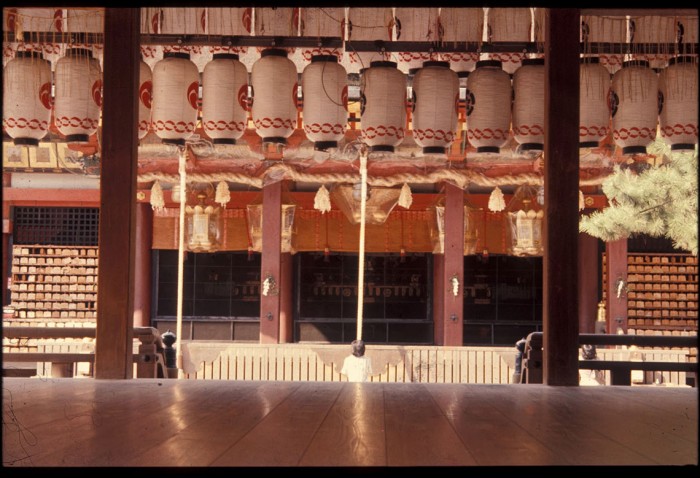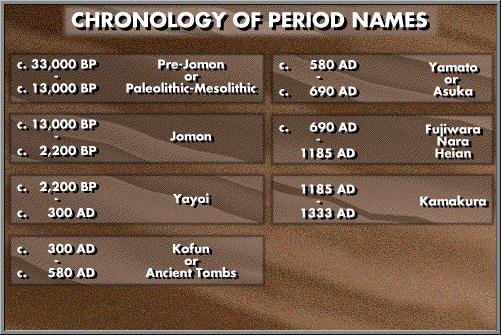
Shinto is Japan’s native religion. It is often called ‘The Way of the Gods’ because it is written with two Chinese characters which can be so translated. Shinto often seems to be a confusing amalgam of beliefs because it combines a huge variety of local traditions with a more tightly defined body of beliefs important to the theoretical underpinnings of the ancient Japanese state in the Nara and Heian periods (710-794 and 794-1185) and again under the Meiji state and constitution (1868-1945). Reflecting the unexclusive nature of the religion, most Japanese profess to believe in Shinto as well as Buddhism.

The earliest books about Shinto were the Kojiki and the Nihon shoki which were compilations of beliefs, stories of the gods, and political histories composed to entrench the imperial family at the top of the religious and political communities. Amaterasu Omikami or the Sun Goddess, the imperial family’s ancestor and goddess, was placed at the head of the Shinto pantheon, reflecting the emperor’s superior political position. This systematization of Shinto was caused in part by the intrusion of Buddhism, Taoism and Confucianism into Japan: these Chinese systems imparted some beliefs and logic to Shinto at the same time that they threatened to overwhelm it.
Shinto, however, was intimately connected with ideas of fertility and purification which were crucial to local communities as well as the new Japanese state, so rather than being crushed, Shinto defined itself and coexisted with the new ideas. Buddhism intruded at the popular level in part by identifying its beliefs and gods with those of Shinto. The two religions were also close physically since Buddhist temples were frequently built immediately adjacent to Shinto shrines or vice versa; the idea was that the shrines would protect the Buddhist temples by placating the local deities. In 743, a messenger was sent to the Sun Goddess at Ise Shrine to make inquiries regarding the location of a large Buddhist temple (Todaiji) that was planned in Nara and it was revealed that the Sun Goddess considered herself and the cosmic Buddha two manifestations of the same reality. The tendency to combine the two dissimilar religions became even more prominent in the 13-19th centuries when there developed Ryobu Shinto (‘Dual Shinto’). During this period, Buddhist priests functioned as both Shinto and Buddhist priests and it became virtually impossible to differentiate the two.
At the end of the Edo period, the School of National Learning revived interest in all aspects of ancient Japanese culture. Shinto began once again to be defined as separate from Buddhism. In the Meiji period (1868-1912), state Shinto was developed as an important part of the ideology of the government. The identification between Shinto and the imperial family in ancient times was revived and used, together with the prominent role of the emperor, to provided legitimacy and focus the loyalty of the population. In addition to state Shinto, there is a large number of local and idiosyncratic Shinto traditions based on local Shinto shrines plus several new Shinto sects with nation-wide stature. Many of these new sects emerged in the late 19th century and prosper today.
Shinto shrines are notable for their location and their architecture. Shrines are commonly in places of natural beauty where they can serve as intermediaries between man and the natural world. The entrance is usually marked by a wooden gate (torii) and straw ropes festooned with folded white paper strips enshrine the purity of the building or the central religious object (a unique rock or tree, for example). Rituals focus heavily on food offerings, including [sake (rice wine), to the gods and often end with consumption of the food by worshippers. Purification is a crucial matter in Shinto. Impurity resulting from death or blood requires washing while inner impurity may need sincere repentance and ritual offerings. Purification is important even in a sport like sumo where wrestlers carefully purify the venue by throwing salt and themselves by washing out their mouths with water and, currently popular, sprinkling salt on injuries.
The Shinto concept of god is a complex one. Kami is the word translated by ‘god’ and is used in Christianity for their God. However, in Japanese, the word has a variety of meanings depending on circumstances. A kami is thought to reside in or around sacred objects like trees, rocks or even entire mountains or it may be represented by a mirror, sword or other object which is tucked away in a shrine. Individual humans who are exceptional may be viewed as kami: thus, students may pray to Sugawara no Michizane (a scholar, 845-903), ancestors may be termed kami and emperors and some leading daimyo were commonly held to be kami.
Shinto shrine festivals are frequently scenes of great activity. In addition to the rituals which must be performed, the festivals are occasions for the community to gather. Wherever people gather, food and drink are necessary; religious amulets are sold by the priests; theater, sports and dances may be put on; and shops appear in the shrine vicinity. Whether in the countryside or the large cities, shrine festivals are popular, noisy and entertaining. Shinto is primarily a religion of life and reproduction. Marriages are a typical Shinto function and so to is the ritual of taking children to shrines for special blessings. Girls are taken for blessings when they turn three and seven years of age and boys when they turn five. Babies are also often taken to shrines for protective blessings as soon as they are old enough to leave the house. Buddhism may be primarily concerned with what happens after death, but Shinto is firmly rooted in this life.
In the Edo period, people began to emphasize not just going to a shrine from time to time, but visiting many shrines. This reflects the basic eclecticism of Shintoism, in part, but also the growth of the idea that one should show respect to other people’s beliefs. From this grew a stimulus to depart on pilgrimages, a form of tourism which grew to such an extent that the Tokugawa shogunate actually banned it in the period 1831-45 as an economic austerity policy. Pilgrimages performed an important role in breaking down the barriers between distant parts of Japan at the same time that they increased the commerce which took place along highways like the Nakasendo.

